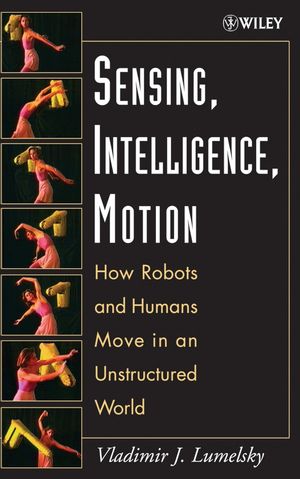Sensing, Intelligence, Motion: How Robots and Humans Move in an Unstructured WorldISBN: 978-0-471-70740-0
Hardcover
456 pages
November 2005
 This is a Print-on-Demand title. It will be printed specifically to fill your order. Please allow an additional 10-15 days delivery time. The book is not returnable.
|
||||||
Acknowledgments.
1 Motion Planning—Introduction.
1.1 Introduction.
1.2 Basic Concepts.
1.2.1 Robot? What Robot?
1.2.2 Space. Objects.
1.2.3 Input Information. Sensing.
1.2.4 Degrees of Freedom. Coordinate Systems.
1.2.5 Motion Control.
1.2.6 Robot Programming.
1.2.7 Motion Planning.
2 A Quick Sketch of Major Issues in Robotics.
2.1 Kinematics.
2.2 Statics.
2.3 Dynamics.
2.4 Feedback Control.
2.5 Compliant Motion.
2.6 Trajectory Modification.
2.7 Collision Avoidance.
2.8 Motion Planning with Complete Information.
2.9 Motion Planning with Incomplete Information.
2.9.1 The Beginnings.
2.9.2 Maze-to-Graph Transition.
2.9.3 Sensor-Based Motion Planning.
2.10 Exercises.
3 Motion Planning for a Mobile Robot.
3.1 The Model.
3.2 Universal Lower Bound for the Path Planning Problem.
3.3 Basic Algorithms.
3.3.1 First Basic Algorithm: Bug1.
3.3.2 Second Basic Algorithm: Bug2.
3.4 Combining Good Features of Basic Algorithms.
3.5 Going After Tighter Bounds.
3.6 Vision and Motion Planning.
3.6.1 The Model.
3.6.2 Algorithm VisBug-21.
3.6.3 Algorithm VisBug-22.
3.7 From a Point Robot to a Physical Robot.
3.8 Other Approaches.
3.9 Which Algorithm to Choose?
3.10 Discussion.
3.11 Exercises.
4 Accounting for Body Dynamics: The Jogger’s Problem.
4.1 Problem Statement.
4.2 Maximum Turn Strategy.
4.2.1 The Model.
4.2.2 Sketching the Approach.
4.2.3 Velocity Constraints. Minimum Time Braking.
4.2.4 Optimal Straight-Line Motion.
4.2.5 Dynamics and Collision Avoidance.
4.2.6 The Algorithm.
4.2.7 Examples.
4.3 Minimum Time Strategy.
4.3.1 The Model.
4.3.2 Sketching the Approach.
4.3.3 Dynamics and Collision Avoidance.
4.3.4 Canonical Solution.
4.3.5 Near-Canonical Solution.
4.3.6 The Algorithm.
4.3.7 Convergence. Computational Complexity.
4.3.8 Examples.
5 Motion Planning for Two-Dimensional Arm Manipulators.
5.1 Introduction.
5.1.1 Model and Definitions.
5.2 Planar Revolute–Revolute (RR) Arm.
5.2.1 Analysis.
5.2.2 Algorithm.
5.2.3 Step Planning.
5.2.4 Example.
5.2.5 Motion Planning with Vision and Proximity Sensing.
5.2.6 Concluding Remarks.
5.3 Distinct Kinematic Configurations of RR Arm.
5.4 Prismatic–Prismatic (PP, or Cartesian) Arm.
5.5 Revolute–Prismatic (RP) Arm with Parallel Links.
5.6 Revolute–Prismatic (RP) Arm with Perpendicular Links.
5.7 Prismatic–Revolute (PR) Arm.
5.8 Topology of Arm’s Free Configuration Space.
5.8.1 Workspace; Configuration Space.
5.8.2 Interaction Between the Robot and Obstacles.
5.8.3 Uniform Local Connectedness.
5.8.4 The General Case of 2-DOF Arm Manipulators.
5.9 Appendix.
5.10 Exercises.
6 Motion Planning for Three-Dimensional Arm Manipulators.
6.1 Introduction.
6.2 The Case of the PPP (Cartesian) Arm.
6.2.1 Model, Definitions, and Terminology.
6.2.2 The Approach.
6.2.3 Topology of W-Obstacles and C-Obstacles.
6.2.4 Connectivity of C.
6.2.5 Algorithm.
6.2.6 Examples.
6.3 Three-Link XXP Arm Manipulators.
6.3.1 Robot Arm Representation Spaces.
6.3.2 Monotonicity of Joint Space.
6.3.3 Connectivity of Jf.
6.3.4 Retraction of Jf.
6.3.5 Configuration Space and Its Retract.
6.3.6 Connectivity Graph.
6.3.7 Lifting 2D Algorithms into 3D.
6.3.8 Step Planning.
6.3.9 Discussion.
6.4 Other XXX Arms.
7 Human Performance in Motion Planning.
7.1 Introduction.
7.2 Preliminary Observations.
7.2.1 Moving in a Maze.
7.2.2 Moving an Arm Manipulator.
7.2.3 Conclusions and Plan for Experiment Design.
7.3 Experiment Design.
7.3.1 The Setup.
7.3.2 Test Protocol.
7.4 Results—Experiment One.
7.4.1 Principal Components Analysis.
7.4.2 Nonparametric Statistics.
7.4.3 Univariate Analysis of Variance.
7.4.4 Two-Way Analysis of Variance.
7.4.5 Implementation: Two-Way Analysis for Path Length.
7.4.6 Implementation: Two-Way Analysis for Completion Time.
7.5 Results—Experiment Two.
7.5.1 The Technique.
7.5.2 Implementation Scheme.
7.5.3 Results and Interpretation.
7.6 Discussion.
8 Sensitive Skin—Designing an All-Sensitive Robot Arm Manipulator.
8.1 Introduction.
8.2 Salient Characteristics of a Sensitive Skin.
8.3 Skin Design.
8.4 Examples.
9 Suggested Course Projects.
References.
Index.



